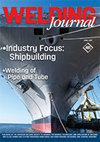加热速率对奥氏体形成的影响
IF 1.4
3区 材料科学
Q2 METALLURGY & METALLURGICAL ENGINEERING
引用次数: 1
摘要
焊接中的热影响区(HAZ)的范围通常是从奥氏体化的热力学考虑来估计的;然而,热力学是微合金钢热影响区位置的一个很差的预测器。本工作通过研究具有初始铁素体和贝氏体组织的X80级管道钢在连续加热过程中奥氏体的形成来解决这一问题。方法包括膨胀测量法、电子显微镜和热力学计算。在1˚~ 500˚C/s的升温速率范围内,绘制了连续升温转换图。当加热速率较慢时,奥氏体的开始转变温度高于平衡所规定的温度,而当加热速率较快时,开始转变温度逐渐接近理论计算的温度,在该温度下铁素体可以(可能通过大规模转变)不进行远距离扩散而转变为奥氏体。部分转变实验表明,奥氏体的形成经历了两个阶段:1)贝氏体向奥氏体的转变,2)多边形铁素体晶粒的转变。本文章由计算机程序翻译,如有差异,请以英文原文为准。
Effect of the Heating Rate on Austenite Formation
The extent of the heat-affected zone (HAZ) in welding is typically estimated from thermodynamic considerations of austenization; however, thermodynamics are a poor predictor of the HAZ location in microalloyed steels. This work addresses the problem through the study of austenite formation during continuous heating on a grade X80 pipeline steel with an initial ferritic and bainitic microstructure. The methodology involved dilatometry, electron microscopy, and thermodynamic calculations. A continuous heating transformation diagram was developed for heating rates varying from 1˚ to 500˚C/s. For the slower heating rates, austenite start-transformation temperature was higher than the one dictated by the equilibrium, while for the faster heating rates, start-transformation temperature gradually approached the theoretically calculated temperature at which the ferrite can transform (possibly through a massive transformation) without a long-range diffusion into austenite. Partial-transformation experiments suggested that austenite formation occurs in the following two stages: 1) the transformation of bainitic zones into austenite, and later, 2) the transformation of polygonal ferritic grains.
求助全文
通过发布文献求助,成功后即可免费获取论文全文。
去求助
来源期刊

Welding Journal
工程技术-冶金工程
CiteScore
3.00
自引率
0.00%
发文量
23
审稿时长
3 months
期刊介绍:
The Welding Journal has been published continually since 1922 — an unmatched link to all issues and advancements concerning metal fabrication and construction.
Each month the Welding Journal delivers news of the welding and metal fabricating industry. Stay informed on the latest products, trends, technology and events via in-depth articles, full-color photos and illustrations, and timely, cost-saving advice. Also featured are articles and supplements on related activities, such as testing and inspection, maintenance and repair, design, training, personal safety, and brazing and soldering.
 求助内容:
求助内容: 应助结果提醒方式:
应助结果提醒方式:


